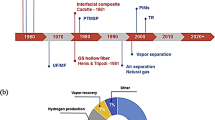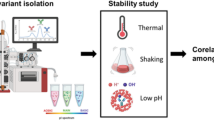Abstract
Synthetic polymers have complex molecular structures with distributions in molar mass, chemical composition, functionality and molecular topology. For the comprehensive analysis of polymer structures, a number of advanced spectroscopic and fractionation techniques are used. For the fractionation of polymers, most frequently column-based methods are applied. These are of limited value for the separation of very high molar mass and fragile analytes. Thermal field-flow fractionation (ThFFF) as a channel-based method has developed into a powerful alternative and complementary technique to column-based fractionations. This perspective discusses novel applications of ThFFF and highlights its potential for the fractionation of polymer assemblies such as micelles, vesicles and nanogels.

Copyright 2019, adapted with permission of Springer Nature

Copyright 2014, Reproduced with permission of Wiley Interscience

Copyright 2017, adapted from [12] with permission of American Chemical Society

Copyright 2019, Reproduced with permission of American Chemical Society

Copyright 2020, Reproduced with permission of Elsevier
Similar content being viewed by others
Change history
31 May 2021
A Correction to this paper has been published: https://doi.org/10.1007/s10337-021-04055-6
References
Schimpf ME, Caldwell K, Giddings JC (2000) Field-flow fractionation handbook. Wiley, New York
Greyling G, Pasch H (2019) Thermal field-flow fractionation of polymers. Springer, Cham (ISBN: 978-3-030-10649-2)
Ponyik C, Wu D, Williams SK (2013) Separation and composition distribution determination of triblock copolymers by thermal field-flow fractionation. Anal Bioanal Chem 405:9033–9040
Runyon JR, Williams SKR (2011) Composition and molecular weight analysis of styrene-acrylic copolymers using thermal field-flow fractionation. J Chromatogr A 1218:6774–6779
Runyon JR, Williams SKR (2011) Characterization of complex polymers using thermal field-flow fractionation coupled with online multiangle and dynamic light scattering and differential refractive index detection. Polym Prepr (Am Chem Soc, Div Polym Chem) 52:230–231
Malik MI, Pasch H (2016) Field-flow fractionation: new and exciting perspectives in polymer analysis. Progr Polym Sci 63:42–85. https://doi.org/10.1016/j.progpolymsci.2016.03.004
Greyling G, Pasch H (2014) Multidetector thermal field-flow fractionation as a novel tool for the microstructure separation of polyisoprene and polybutadiene. Macromol Rapid Commun 35:1846–1851. https://doi.org/10.1002/marc.201400405
Greyling G, Pasch H (2015) Tacticity separation of poly(methyl methacrylate) by multidetector thermal field-flow fractionation. Anal Chem 87:3011–3018. https://doi.org/10.1021/ac504651p
Greyling G, Pasch H (2015) Fractionation of poly(butyl methacrylate) by molecular topology using multidetector thermal field-flow fractionation. Macromol Rapid Commun 36:2143–2148. https://doi.org/10.1002/marc.201500429
Greyling G, Pasch H (2016) Multidetector thermal field-flow fractionation: a unique tool for monitoring the structure and dynamics of block copolymer micelles. Macromolecules 49:1882–1889. https://doi.org/10.1021/acs.macromol.5b02634
Greyling G, Pasch H (2015) Multidetector thermal field-flow fractionation as a unique tool for the tacticity-based separation of poly(methyl methacrylate)-polystyrene block copolymer micelles. J Chromatogr A 1414:163–172. https://doi.org/10.1016/j.chroma.2015.08.023
Muza UL, Greyling G, Pasch H (2017) Characterization of complex polymer self-assemblies and large aggregates by multidetector thermal field-flow fractionation. Anal Chem 89:7216–7224. https://doi.org/10.1021/acs.analchem.7b01445
Muza UL, Pasch H (2019) Thermal field-flow fractionation with quintuple detection for the comprehensive analysis of complex polymers. Anal Chem 91:6926–6933. https://doi.org/10.1021/acs.analchem.9b01384
Hiller W, van Aswegen W, Hehn M, Pasch H (2013) Online ThFFF-NMR: a novel tool for molar mass and chemical composition analysis of complex macromolecules. Macromolecules 46:2544–2552. https://doi.org/10.1021/ma400350y
Radebe NW, Beskers T, Greyling G, Pasch H (2019) Online coupling of thermal field-flow fractionation and FTIR as a new tool for polymer characterization. J Chromatogr A 1587:180–188. https://doi.org/10.1016/j.chroma.2018.12.012
Viktor Z, Pasch H (2020) Two-dimensional fractionation of complex polymers by comprehensive online-coupled thermal field-flow fractionation and size exclusion chromatography. Anal Chim Acta 1107:225–232. https://doi.org/10.1016/j.aca.2020.02.033
Geisler M, Lederer A (2020) Non-parabolicity correction for fifty-nine solvents and a retention study for strongly distorted flow-profiles in thermal field-flow fractionation. J Chromatogr A 1621:461082. https://doi.org/10.1016/j.chroma.2020.461082
Funding
There is no funding to report.
Author information
Authors and Affiliations
Corresponding author
Ethics declarations
Conflict of interest
There is no conflict of interest to report.
Ethical approval
This article does not contain any studies with animals or human participants.
Additional information
Publisher's Note
Springer Nature remains neutral with regard to jurisdictional claims in published maps and institutional affiliations.
Rights and permissions
About this article
Cite this article
Pasch, H. Thermal Field-Flow Fractionation as a Powerful Tool for the Fractionation of Complex Synthetic Polymers: A Perspective. Chromatographia 84, 525–530 (2021). https://doi.org/10.1007/s10337-021-04036-9
Received:
Revised:
Accepted:
Published:
Issue Date:
DOI: https://doi.org/10.1007/s10337-021-04036-9




